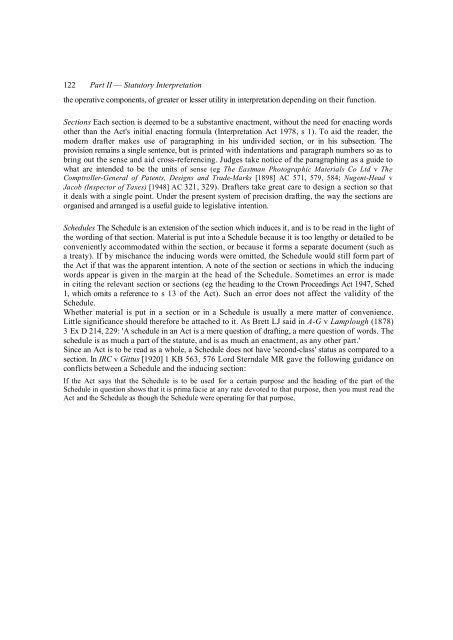Statutory Interpretation The Technique of Statutory ... - Francis Bennion
Statutory Interpretation The Technique of Statutory ... - Francis Bennion
Statutory Interpretation The Technique of Statutory ... - Francis Bennion
Create successful ePaper yourself
Turn your PDF publications into a flip-book with our unique Google optimized e-Paper software.
122 Part II — <strong>Statutory</strong> <strong>Interpretation</strong><br />
the operative components, <strong>of</strong> greater or lesser utility in interpretation depending on their function.<br />
Sections Each section is deemed to be a substantive enactment, without the need for enacting words<br />
other than the Act's initial enacting formula (<strong>Interpretation</strong> Act 1978, s 1). To aid the reader, the<br />
modern drafter makes use <strong>of</strong> paragraphing in his undivided section, or in his subsection. <strong>The</strong><br />
provision remains a single sentence, but is printed with indentations and paragraph numbers so as to<br />
bring out the sense and aid cross-referencing. Judges take notice <strong>of</strong> the paragraphing as a guide to<br />
what are intended to be the units <strong>of</strong> sense (eg <strong>The</strong> Eastman Photographic Materials Co Ltd v <strong>The</strong><br />
Comptroller-General <strong>of</strong> Patents, Designs and Trade-Marks [1898] AC 571, 579, 584; Nugent-Head v<br />
Jacob (Inspector <strong>of</strong> Taxes) [1948] AC 321, 329). Drafters take great care to design a section so that<br />
it deals with a single point. Under the present system <strong>of</strong> precision drafting, the way the sections are<br />
organised and arranged is a useful guide to legislative intention.<br />
Schedules <strong>The</strong> Schedule is an extension <strong>of</strong> the section which induces it, and is to be read in the light <strong>of</strong><br />
the wording <strong>of</strong> that section. Material is put into a Schedule because it is too lengthy or detailed to be<br />
conveniently accommodated within the section, or because it forms a separate document (such as<br />
a treaty). If by mischance the inducing words were omitted, the Schedule would still form part <strong>of</strong><br />
the Act if that was the apparent intention. A note <strong>of</strong> the section or sections in which the inducing<br />
words appear is given in the margin at the head <strong>of</strong> the Schedule. Sometimes an error is made<br />
in citing the relevant section or sections (eg the heading to the Crown Proceedings Act 1947, Sched<br />
1, which omits a reference to s 13 <strong>of</strong> the Act). Such an error does not affect the validity <strong>of</strong> the<br />
Schedule.<br />
Whether material is put in a section or in a Schedule is usually a mere matter <strong>of</strong> convenience.<br />
Little significance should therefore be attached to it. As Brett LJ said in A-G v Lamplough (1878)<br />
3 Ex D 214, 229: 'A schedule in an Act is a mere question <strong>of</strong> drafting, a mere question <strong>of</strong> words. <strong>The</strong><br />
schedule is as much a part <strong>of</strong> the statute, and is as much an enactment, as any other part.'<br />
Since an Act is to be read as a whole, a Schedule does not have 'second-class' status as compared to a<br />
section. In IRC v Gittus [1920] 1 KB 563, 576 Lord Sterndale MR gave the following guidance on<br />
conflicts between a Schedule and the inducing section:<br />
If the Act says that the Schedule is to be used for a certain purpose and the heading <strong>of</strong> the part <strong>of</strong> the<br />
Schedule in question shows that it is prima facie at any rate devoted to that purpose, then you must read the<br />
Act and the Schedule as though the Schedule were operating for that purpose,

















